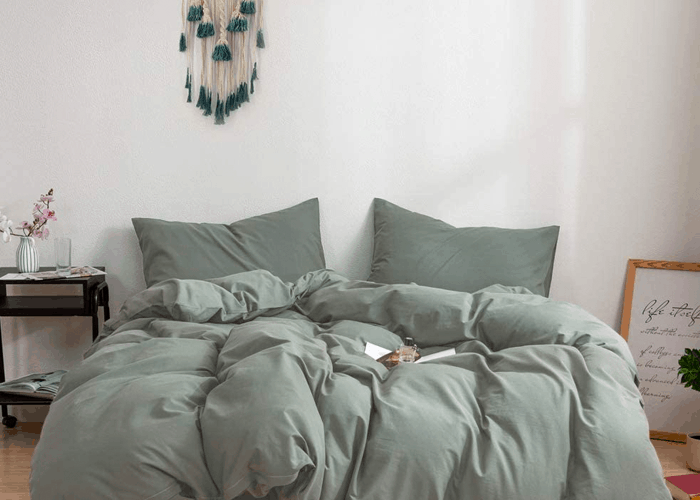What’s the ideal color for bedding to complement your white walls? This article offers a helpful guide on selecting the perfect bedding colors for your white bedroom.
Since white is a neutral colour, it is incredibly versatile. No matter what colour you choose for your bedding, you cannot go wrong. However, make sure you understand the tone of the white. If it is a warm tone, cool undertones will be better. If it is a cool-toned white, then warmer shades will look better against it.
Since we’ve already established that white is a pretty versatile colour, it will all come down to your taste. Pick colours that express yourself and colours that you will feel comfortable in. Since you are choosing bedding for a bedroom, choose colours that make you feel calm and safe.
How to Find the Best colour for White Walls?
Selecting the right colour can be easy with the correct methods. Here are the steps you can follow for choosing the best colour for white walls:
Identify the Primary colour
Identifying the primary colour of the room for a project like this is very important. Proper insight into the colour will help us understand how we can use the light in the room to our advantage. One straightforward method to identify the colour is to take a picture of the room and upload it to this colour identifier tool.
The tool will provide not only the name but the exact hex value of the shade. Having hex values of shades can help us be more precise when choosing colour matches.
Develop a colour Palette
After you’ve found the exact hex value of the white we are dealing with, you can create a colour palette. A colour palette will help you tell your story through the different colours without any clashes. Of course, you can create one on your own. However, there is a more straightforward method.
Head over to the Adobe colour Wheel website. It is a tool for creating the most suitable colour combinations in different colour schemes.
To use this tool, follow these 2 steps:
- Choose one scheme from the different colour schemes/ rules given on the left corner of the website. The main ones are the first four.
- Next, type out the hex value of your primary colour below the first colour from the left. After which, you will get four different colour matches.
Different colour Schemes
To understand which scheme you want to go for, here are brief descriptions of the central schemes for the colour white.
Analogous
Analogous colours fall next to each other on the colour wheel. So with white, analogous colours are pastels which can provide a very soft muted look. However, they can wash out the room as well, so be careful.
Monochrome
Monochrome colours are created by adding light or dark to the base colour. For white, monochromatic colours are usually greys and blacks. You can use this scheme if you like darker, minimalist spaces.
Triadic
Triadic colours are 3 colours separated evenly from each other. Usually, they are dramatic combos like blue, yellow, and red. However, white creates relatively muted and cool matches like blues, greys, and even warmer colours like ecru.
Best colours to Match White Walls
Here are some of the best colours that go with white walls:
- White: White beddings against white walls have always been a very safe and easy option. It gives an immaculate and modern look, and you don’t compromise on versatility. Adding other colours over this white base is very simple if you want to make any minor changes. Here are some of the best colours that go with white walls:
- Grey: Another choice similar to white, grey is an excellent choice if you want to stick to the clean look. However, unlike white, it is easier to maintain, and you get a wide range of shades to choose from.
- Patterns and Stripes: Patterned bedding goes incredibly well with white walls. You can choose anything from floral to stripes and even geometric shapes. The good idea is to pay attention to the base colour of the patterns. Keep the base colour consistent throughout the different components. It will help you keep things seamless even though you’re using so many different colours.
- Blues: Blue is an excellent colour for beddings. Usually, you can mix different kinds of blues in one space without causing much clashing. This is because most blues are usually the same tone making them very easy to work with.
- Tan: Tan is like yellow, but it has a warmer undertone. Using tan against white creates a unique look that is contrasting without being too heavy. It also creates a very warm and inviting space without being overbearing.
Other Ideas
Here are some other ideas that do not necessarily require a single colour:
- Nature Theme: Go with patterned bedding that has flowers, leaves, or similar patterns. You can pair these patterned bedding with solid colours that you might find in nature. Use greens, browns, reds, and yellows as accents on pillow covers, cushions, and curtains. You can even add house plants in the room to give it an outdoor feel. You could take this a step further and use bamboo duvets and products.
- Multi-coloured: Pick a solid colour like white for the sheets and then add colours to other components. You can pick pillow covers, cushions, and comforters in different shades. It might sound too contrasting, but there is a method to executing this. Choose one colour and make sure it is used in all the different components.
- Single-Shade Accents: Pick another shade like grey for the comforters. Then pick a vibrant colour like lime, cerulean, or even rust. Keep the colour consistent on smaller components like cushions and pillow covers. The neutral base of grey and white paired with a single bright shade will give you a dramatic effect being too jarring.
Conclusion
White walls are easy to match with and go with all colours. You only need to pick a specific theme or colour scheme for your bedding. However, although most colours go with white, remember to keep the scheme consistent lest it turns out a little crazy-looking. This is especially so when you want to add more colours and patterns in a single space. Developing a colour palette can help you understand the way the colours interact with one another.
You can go in all directions with white—muted, minimalist or contrasting.

 Nectar Mattress
Nectar Mattress 


